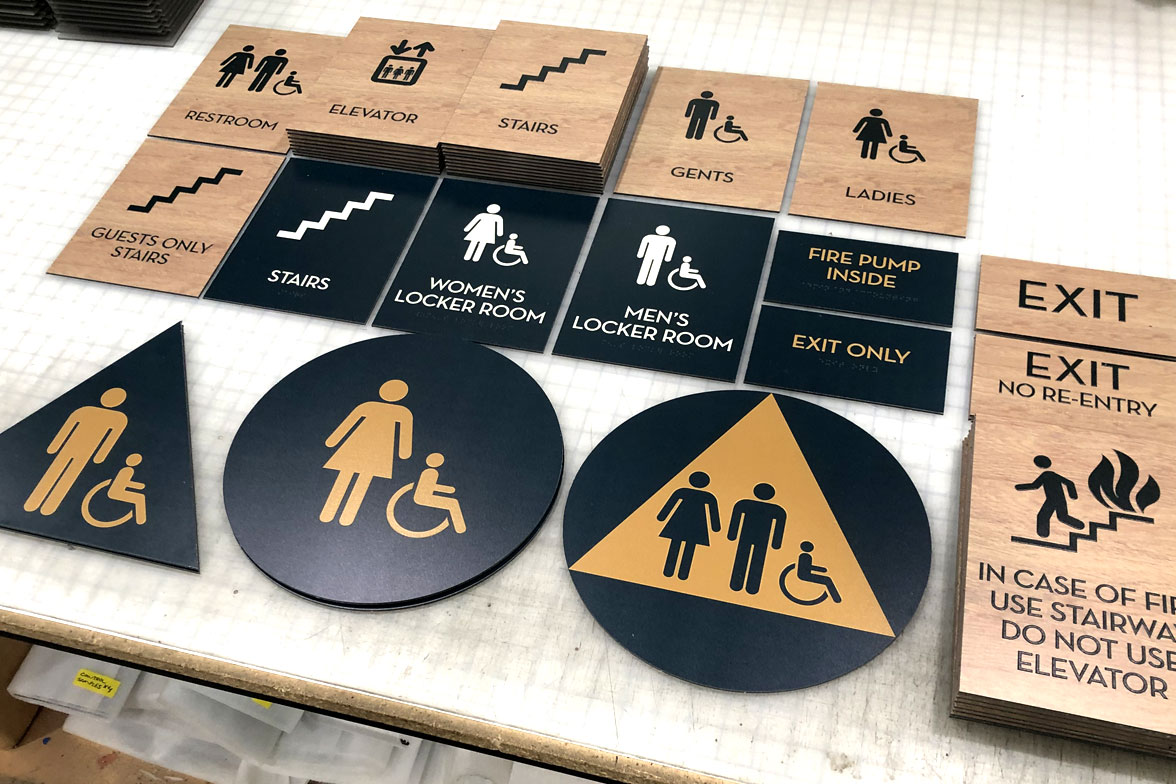The Function of ADA Signs in Adhering To Ease Of Access Standards
Wiki Article
Exploring the Secret Functions of ADA Indications for Enhanced Accessibility
In the world of access, ADA indications serve as quiet yet powerful allies, ensuring that rooms are accessible and comprehensive for people with impairments. By incorporating Braille and tactile components, these indicators break obstacles for the visually damaged, while high-contrast shade schemes and clear typefaces cater to diverse aesthetic demands.Value of ADA Compliance
Ensuring conformity with the Americans with Disabilities Act (ADA) is crucial for fostering inclusivity and equivalent access in public areas and offices. The ADA, enacted in 1990, mandates that all public facilities, employers, and transport solutions accommodate people with impairments, guaranteeing they appreciate the same rights and chances as others. Compliance with ADA standards not only meets legal obligations but likewise boosts a company's reputation by demonstrating its dedication to variety and inclusivity.One of the vital elements of ADA conformity is the execution of obtainable signage. ADA indicators are designed to guarantee that individuals with specials needs can easily navigate via buildings and areas.
Moreover, sticking to ADA regulations can mitigate the danger of potential fines and legal effects. Organizations that fail to abide by ADA guidelines may deal with lawsuits or penalties, which can be both harmful and monetarily burdensome to their public picture. Hence, ADA compliance is essential to cultivating an equitable setting for everyone.
Braille and Tactile Components
The consolidation of Braille and tactile components into ADA signs embodies the concepts of accessibility and inclusivity. These attributes are vital for people who are aesthetically damaged or blind, allowing them to navigate public rooms with higher self-reliance and confidence. Braille, a responsive writing system, is vital in supplying created information in a style that can be quickly perceived via touch. It is commonly placed below the corresponding text on signage to guarantee that individuals can access the info without aesthetic support.Responsive aspects expand past Braille and consist of raised personalities and icons. These elements are created to be noticeable by touch, enabling individuals to determine room numbers, washrooms, leaves, and other vital locations. The ADA establishes details standards pertaining to the dimension, spacing, and placement of these responsive aspects to enhance readability and make sure uniformity across different atmospheres.

High-Contrast Color Design
High-contrast color design play a critical duty in improving the exposure and readability of ADA signs for people with aesthetic impairments. These schemes are essential as they make the most of the distinction in light reflectance between text and history, ensuring that indications are conveniently discernible, also from a distance. The Americans with Disabilities Act (ADA) mandates the use of particular color contrasts to suit those with restricted vision, making it a critical element of compliance.The efficiency of high-contrast shades depends on their capability to stick out in various lights problems, consisting of dimly lit environments and locations with glare. Typically, dark text on a light background or light text on a dark history is employed to achieve optimum contrast. For circumstances, black text on a white or yellow history provides a plain visual difference that helps in quick acknowledgment and comprehension.

Legible Fonts and Text Dimension
When thinking about the layout of ADA signage, the choice of readable typefaces and appropriate message size can not be overstated. The Americans with Disabilities Act (ADA) mandates that font styles must be sans-serif and not italic, oblique, script, extremely ornamental, or of unusual type.The size of the text additionally plays a critical duty in accessibility. According to ADA guidelines, the minimum message elevation must be 5/8 inch, and it should increase proportionally with viewing range. This is especially essential in public spaces where signage requirements to be checked out promptly and accurately. Consistency in message dimension adds to a natural visual experience, helping people in navigating environments effectively.
In addition, spacing between lines and letters is indispensable to readability. Appropriate spacing protects against personalities click for info from appearing crowded, improving readability. By sticking to these standards, developers can substantially enhance ease of access, guaranteeing that signage serves its desired objective for all people, despite their visual capacities.
Reliable Placement Methods
Strategic placement of ADA signs is important for taking full advantage of availability and making sure conformity with lawful requirements. ADA guidelines state that signs ought to be installed at an elevation between 48 to 60 inches from the ground to ensure they are within the line of sight for both standing and seated individuals.In addition, indications should be put beside the latch side of doors to enable very easy recognition before entry. This positioning assists individuals situate spaces and rooms without obstruction. In instances where there is no door, indicators look what i found should be positioned on the closest surrounding wall. Consistency in indication positioning throughout a facility improves predictability, reducing confusion and improving general individual experience.

Conclusion
ADA signs play a crucial duty in advertising accessibility by incorporating features that attend to the requirements of individuals with impairments. Including Braille and tactile components ensures essential info is accessible to the aesthetically impaired, while high-contrast shade schemes and clear sans-serif typefaces boost presence across various lights problems. Efficient positioning methods, such as proper placing heights and tactical locations, further help with navigating. These aspects collectively foster an inclusive setting, highlighting the significance of ADA compliance in ensuring equal accessibility for all.In the world of accessibility, ADA indications offer as quiet yet effective allies, making sure that spaces are comprehensive and accessible for people with disabilities. The ADA, enacted in 1990, mandates that all public facilities, employers, Full Report and transport solutions suit individuals with handicaps, guaranteeing they appreciate the exact same rights and possibilities as others. ADA Signs. ADA indicators are developed to make certain that people with handicaps can quickly browse via areas and structures. ADA standards state that indications ought to be placed at an elevation between 48 to 60 inches from the ground to ensure they are within the line of sight for both standing and seated people.ADA signs play an essential role in promoting ease of access by integrating attributes that address the demands of people with handicaps
Report this wiki page